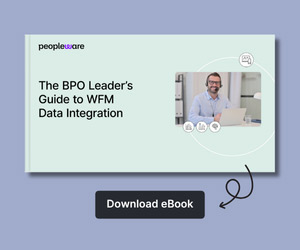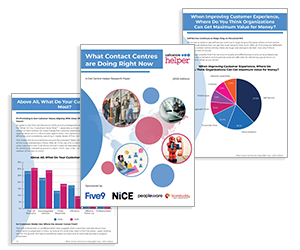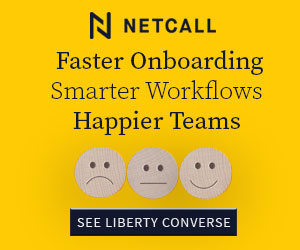Zaineb Ahmed at Peopleware explores the impact of employee engagement on customer satisfaction, common pitfalls to avoid when trying to engage employees and successful strategies to engage employees in contact centres.
In high-pressure contact centres, customer satisfaction is often directly linked to the success of applied strategies to engage employees.
The more engaged your employees are, the more productive they will be in providing better-quality service to your customers.
According to Gallup’s State of the Global Workplace report, employee engagement has declined to 21% in 2024. This is a worrying sign for contact centres already struggling with productivity, turnover, and low customer satisfaction scores.
Employee engagement can make or break service outcomes in an environment where customer satisfaction depends on resolving real-time issues, consistently meeting demand, and dealing with high uncertainty.
Impact of Employee Engagement on Customer Satisfaction
For contact centres, employee engagement is a critical business driver. Disengaged employees often display minimal effort, are prone to making errors, and lack the energy to go the extra mile. Here are 6 signs that your employees are disengaged.
On the other hand, when employees feel motivated, valued, and connected to their work, they’re more likely to:
- Deliver high-quality work
- Resolve customer issues in the first call
- Stay loyal to the company
Common Pitfalls to Avoid When Trying to Engage Employees
Contact centre leaders often fall into the trap of recycling outdated programs and tweaking old strategies that failed in the past. Holding on to these habits under the mindset of ‘that’s how we’ve always done it’ mentality, can undermine both your WFM strategies and employee engagement.
In contact centres, some of these common pitfalls include:
“It Will Take Care of Itself” – Believing That Time Heals All Wounds
Your employees will not magically become engaged once the peak period is over or turnover slows down. Intentional effort is required to engage employees in contact centres and ensure that the level of engagement doesn’t decrease.
“One Size Fits All” – Assuming Standard Software is Enough
Another common mistake contact centre leaders make is failing to equip the workforce with the right tools to do their job, while still expecting high engagement and motivation.
Providing any tool is not the same as providing the right tool. When tools or processes hinder work rather than easing it, it can create frustration, stress, and demotivation, ultimately leading to disengagement.
“Our Leaders Know it All“ – The “That’s Why We Hired Them” Mentality
Assuming that leadership alone can resolve engagement issues simply by implementing strategies, without listening to frontline employees, is a risky mistake. This mindset isolates leaders from the realities their employees face and weakens employee trust and buy-in.
Successful Strategies to Engage Employees in Contact Centres
Start by defining and understanding your organizational culture. Ask yourself: What type of culture do we have or want to build? Is it one centred on “service”, “collaboration”, “innovation”, “risk and reward”, “employee first”, “community/charity”, “employer of choice”, or maybe something completely different? In most cases, it is a combination of values that reflect what matters most to your organization.
Once you have a clear understanding of culture, establish engagement objectives and develop strategies to meet those goals. From our research, successful strategies focus on:
Giving Employees a Voice Through Regular Feedback
Securing employee buy-in greatly increases the chance of success. Use current, relevant, and accurate data when defining engagement strategies and campaigns.
Conducting regular employee engagement surveys provides valuable insight that helps you make an informed, data-driven decision.
Any initiatives to engage employees will be more successful and sustainable when employees are given the opportunity to share input, take ownership of the process, have authority to make meaningful decisions, and are held accountable for outcomes.
Reducing Stress By Using the Right Tools
Whether it’s overworked agents due to inflexible schedules, planners overwhelmed by repeatedly missing service levels, or friction between managers and employees caused by undefined or unclear processes, such as shift bidding, shift swapping, or time off approvals, stress can directly affect engagement levels.
Employees with low engagement levels are more likely to deliver poor service quality, increase turnover, and have a higher rate of absenteeism.
Implementing advanced WFM software and enabling self-service options can alleviate these pressures and empower your employees to perform at their best. Learn more about why prioritizing mental wellness for your employees is important.
Building Trust and Respect by Improving Communication
Defining culture, setting objectives, developing strategies, and implementing initiatives are all essential, but the cornerstones for building an effective engagement culture lie in trust and respect.
To engage employees effectively, leaders must ensure that their teams feel heard and supported. And often, it’s the small things that make the biggest impact.
Jeff Doran shares a great example of how acting on these little things can make a big difference. In a client survey, they determined “convenience amenities” were lacking in the contact centre.
This was the lowest-scoring item on the survey. Specifically, employees did not like walking to the other end of the building to get hot water for tea, soup, etc.
So, management replaced the water cooler with a Hot/Cold water dispenser. Employees were grateful. They no longer had to use their break time to get a cup of hot water.
By letting employees know the management listened to their concerns, they were able to:
- Reduce employee stress
- Increase employee productivity
- Improved employee and management relations
By continuously building trust and respect amongst peers and subordinates, you can make your engagement strategies easier to implement and produce better results.
Summary and Key Takeaways
Employee engagement in contact centres is a critical factor that directly affects business outcomes. When employees become disengaged, organizations often experience declines in service levels, higher attrition, and high absenteeism.
By understanding the connection between employee engagement and customer satisfaction, avoiding common mistakes, and adopting modern employee-centred strategies tailored to the needs of the employees, contact centre leaders can effectively engage employees, enhance service quality, improve customer satisfaction, and reduce attrition.
Here are the key takeaways:
- Engagement matters deeply in contact centres as it drives agents’ behaviour, which drives customer outcomes.
- Engagement isn’t a “one-and-done” campaign. It requires continuous effort from leadership and feedback from the employees to keep the cycle moving.
- An engaged workforce is one that feels ‘seen and heard’. In this regard, small, practical acts (like the hot/cold water dispenser) can have a big impact and signal that you genuinely care.
This blog post has been re-published by kind permission of Peopleware – View the Original Article
For more information about Peopleware - visit the Peopleware Website
Call Centre Helper is not responsible for the content of these guest blog posts. The opinions expressed in this article are those of the author, and do not necessarily reflect those of Call Centre Helper.
Author: Peopleware
Reviewed by: Jo Robinson
Published On: 20th Nov 2025
Read more about - Guest Blogs, Peopleware, Zainab Ahmed






 Peopleware is a leading workforce management (WFM) solution, trusted by over 500,000 users in 30+ countries. With smart forecasting, automated scheduling and real-time management, organizations can optimize workforce efficiency and keep work aligned with demand. From precise time tracking to flexible planning, Peopleware helps organizations boost operational efficiency and foster a more engaged, productive workforce.
Peopleware is a leading workforce management (WFM) solution, trusted by over 500,000 users in 30+ countries. With smart forecasting, automated scheduling and real-time management, organizations can optimize workforce efficiency and keep work aligned with demand. From precise time tracking to flexible planning, Peopleware helps organizations boost operational efficiency and foster a more engaged, productive workforce. 






























